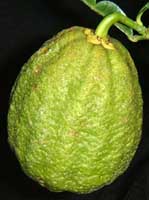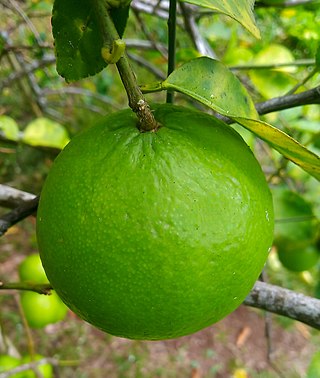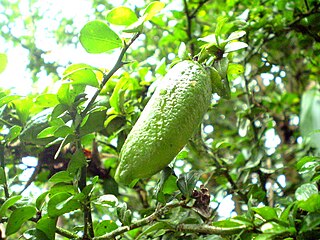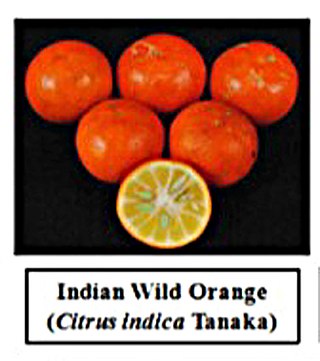
Citrus is a genus of flowering trees and shrubs in the rue family, Rutaceae. Plants in the genus produce citrus fruits, including important crops such as oranges, lemons, grapefruits, pomelos, and limes. The genus Citrus is native to South Asia, East Asia, Southeast Asia, Melanesia, and Australia. Various citrus species have been used and domesticated by indigenous cultures in these areas since ancient times. From there its cultivation spread into Micronesia and Polynesia by the Austronesian expansion ; and to the Middle East and the Mediterranean via the incense trade route, and onwards to Europe and the Americas.

The mandarin orange, also known as mandarin or mandarine, is a small, rounded citrus tree fruit. Treated as a distinct species of orange, it is usually eaten plain or in fruit salads. Tangerines are a group of orange-coloured citrus fruit consisting of hybrids of mandarin orange with some pomelo contribution.

Citrus cavaleriei, the Ichang papeda, is a slow-growing species of papeda that has characteristic lemon-scented foliage and flowers.

The citron, historically cedrate, is a large fragrant citrus fruit with a thick rind. It is said to resemble a 'huge, rough lemon'. It is one of the original citrus fruits from which all other citrus types developed through natural hybrid speciation or artificial hybridization. Though citron cultivars take on a wide variety of physical forms, they are all closely related genetically. It is used in Asian and Mediterranean cuisine, traditional medicines, perfume, and religious rituals and offerings. Hybrids of citrons with other citrus are commercially more prominent, notably lemons and many limes.

Citrus limetta, alternatively considered to be a cultivar of Citrus limon, C. limon 'Limetta', is a species of citrus, commonly known as mousami, musami, sweet lime, sweet lemon, and sweet limetta, it is a member of the sweet lemons. It is small and round like a common lime in shape. It is a cross between the citron and a bitter orange.

Yuzu is a citrus fruit and plant in the family Rutaceae of East Asian origin. Yuzu has been cultivated mainly in East Asia, though recently also in New Zealand, Australia, Spain, Italy, and France.

Persian lime, also known by other common names such as seedless lime, Bearss lime and Tahiti lime, is a citrus fruit species of hybrid origin, known only in cultivation. The Persian lime is a triploid cross between Key lime and lemon.

Sudachi is a small, round, green citrus fruit of Japanese origin that is a specialty of Tokushima Prefecture in Japan. It is a sour citrus, not eaten as fruit, but used as food flavoring in place of lemon or lime. Genetic analysis shows it to be the product of a cross between a yuzu and another citrus akin to the koji and tachibana orange.

The Key lime or acid lime is a citrus hybrid native to tropical Southeast Asia. It has a spherical fruit, 2.5–5 centimetres in diameter. The Key lime is usually picked while it is still green, but it becomes yellow when ripe.

An orange is a fruit of various citrus species in the family Rutaceae ; it primarily refers to Citrus × sinensis, which is also called sweet orange, to distinguish it from the related Citrus × aurantium, referred to as bitter orange.

Citrus australasica, the Australian finger lime or caviar lime, is a thorny understorey shrub or small tree of lowland subtropical rainforest and rainforest in the coastal border region of Queensland and New South Wales, Australia.

Citrus australis, the Dooja, round lime, Australian lime or Australian round lime, is a large shrub or small tree producing an edible fruit. It grows in forest margins in the Beenleigh area and northwards, in Queensland, Australia.

Papeda or papaeda is the common name for a group of Citrus species and varieties native to tropical Asia that are hardy and slow-growing, and produce unpalatable fruit. Walter Tennyson Swingle segregated these species into a separate subgenus, Papeda, that included the Ichang lemon, yuzu, kaffir lime, kabosu, sudachi, and a number of wild and uncultivated species and hybrids. Recent genetic analysis shows the papedas to be distributed among distinct branches of the Citrus phylogenetic tree, and hence Swingle's proposed subgenus is polyphyletic and not a valid taxonomic grouping, but the term persists as a common name.

Citrus macroptera, also known as hatkhora or shatkoracabuyao, Melanesian papeda, or wild orange, is a semi-wild species of citrus native to the Sylhet region of Bangladesh.
Citrus latipes, commonly called "Khasi papeda", is sometimes mistakenly identified as Kaffir lime. Native to Northeast India, the khasi papeda is a small, thorny tree that closely resembles both kaffir limes and ichang papedas. Though rarely eaten, and extremely rare in cultivation, the fruit is edible.
Citrus macrophylla, also known as alemow, is a citrus tree and fruit, belonging to the papedas.
The micrantha is a wild citrus from the papeda group, native to southern Philippines, particularly islands of Cebu and Bohol. Two varieties are recognized: small-flowered papeda, locally known as biasong, and small-fruited papeda or samuyao.

Citrus indica is a species of hybrid Citrus known by the common name Indian wild orange.

Citrus taxonomy refers to the botanical classification of the species, varieties, cultivars, and graft hybrids within the genus Citrus and related genera, found in cultivation and in the wild.














